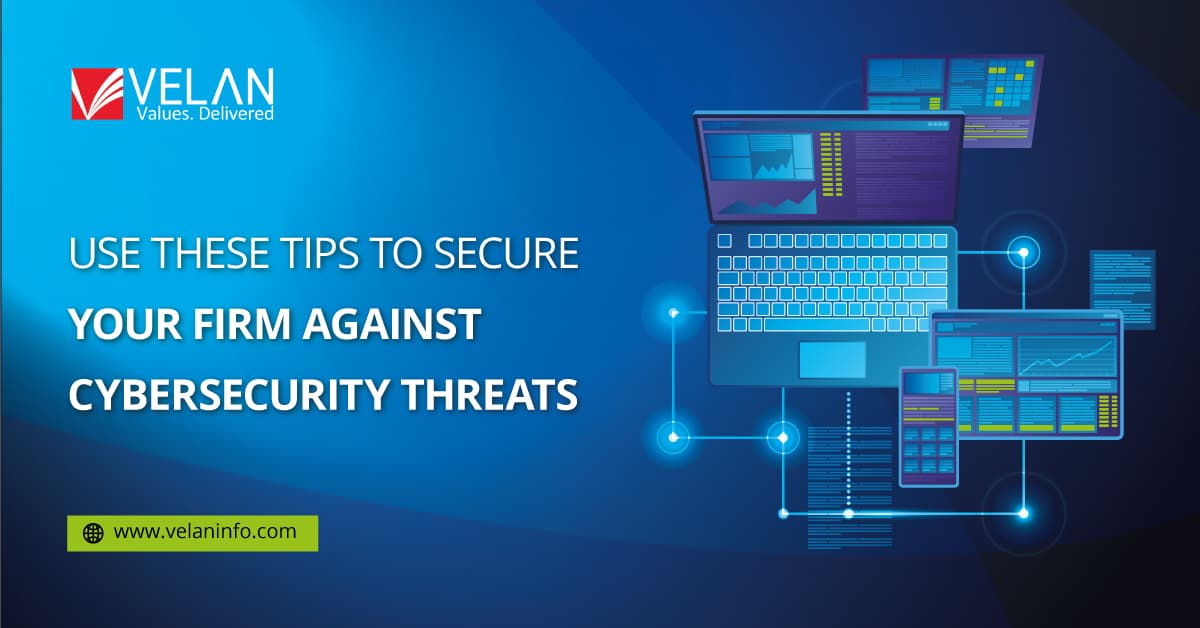Use These Tips To Secure Your Firm Against Cybersecurity Threats 19 Oct 2022

Tables of Content: Cybersecurity Tips
- Implement Least-Privilege Protocol
- Obtain A Password Management Tool
- Insist On Creating Complex Passwords
- Use VPN Whenever Accessing Public Networks
- Use Multi-Factor Authentication Everywhere
- Install The Latest Anti-Malware and Firewall Software
- Equip Your Building With The Best Security Systems
- Have Robust Contingency Plans
- Conclusion
Computers got created to make lives easier by helping with the takeover of many functions that are a part of daily routine, especially for businesses. However, not everyone shared a positive bent of mind towards their use, leading to them creating malicious software (malware) instead to disrupt those functions to varying degrees.
And their effect is only growing each year in intensity and frequency, targeting enterprise data in particular due to the wealth of data and monetary rewards that could get extracted.
Thus, data security has been a growing concern, with businesses expected to spend US$366.1 Billion in 2028 on it. Your business can be a victim of several different cyberattack types at any moment, costing you significantly monetarily and brand reputation-wise. Not to mention the problems your customers will face due to their private data being made public.
So, how do you protect yourself against an imminent and ever-growing threat? By following the below-mentioned proven tips. They will help secure your company against attacks and provide a path to recovery should you fall prey to one.
Tips To Prevent Cybersecurity Threats From Affecting Your Business:
-
Implement Least-Privilege Protocol
Humans continue to be the biggest reason behind the success of cybersecurity breaches. Hence, the more the number of people accessing your systems, especially critical and confidential ones, the more vulnerable your IT infrastructure as a whole becomes. You can counter this information security vulnerability by implementing the principle of least privilege. The concept is simple: the right to access your computer systems gets granted to a minimum number of people who should be accessing them and for the duration of a task only. This strategy prevents unwanted people from gaining access to your systems and diminishing their security level either mistakenly or purposefully,
-
Obtain A Password Management Tool
Protecting your systems against a cyberattack is a complex and perpetual process, so it helps to understand and begin from the basics. And a simple measure you can put in place is using a password manager. People forgetting passwords is commonplace, especially if they have to remember multiple passwords for various access points.
Hence, they tend to create easy passwords that they can remember. But this makes it easy for cybercriminals to hack them. Or in other cases, criminals can obtain the password through other cyberattacks. A password manager protects against such cybersecurity threats by securing the password and entering it on the user’s behalf whenever required. This action stops people from noting down passwords and accidentally revealing them when that writing gets found.
Such tools also offer other security-related options, like permitting password entry based on the IP address and the user’s geographic location. But most important of all, all passwords will be encrypted, saving them from discovery should they get discovered.
-
Insist On Creating Complex Passwords
On the heels of using a password manager, you should also ensure that the passwords you create are complex and lengthy. This move makes them hard to crack as the difficulty of doing so increases by a factor with every additional character used.
It is one of the tech tips that has been in practice since the dawn of the computer age and should be adopted to suit present cybersecurity scenarios. Introducing symbols alongside alphanumeric characters helps in this situation. Password length beyond eight with at least one number and one special character is needed to create a strong password.
-
Use VPN Whenever Accessing Public Networks
In today’s age of geo-agnostic work, you’ll inevitably use a public network to access your company’s data. The biggest problem with this convenience is that public networks are a hacker’s favorite hunting ground. You risk exposing your systems to numerous attacks whenever you use a public network, so you should protect your virtual entry point.
The general cybersecurity tip for this problem is to use a Virtual Private Network (VPN) every time you’re on a public network. There are many VPN products to choose from in the market, so you can select the one that suits your needs and price point. Remember to look for the reputation of the VPN provider before opting for their product, as otherwise, your VPN itself could become your source of a data leak.
-
Use Multi-Factor Authentication Everywhere
The more steps a cybercriminal has to go through to get to your data, the harder it is for them to succeed. That’s the principle behind the implementation of multi-factor authentication. An example is using a password and a One-Time Pin (OTP) together. The concerned person will only be able to access the intended system if both get entered correctly.
The added safety measure is that the pin is sent only to a device the authorized person is using, thus substantially eliminating the risk of unauthorized access. Another way to implement Multi-factor authentication is to use a biometric ID or a physical chip key in place of the OTP.
Information security is improved by increasing the number of factors but can become a cumbersome affair if it’s overdone. You should find the right balance based on the data security level, no. of personnel authorized, type of system, and other influential parameters.
-
Install The Latest Anti-Malware and Firewall Software
Malware is notorious for constantly getting upgraded; its creators are always adding new features to make them more stealthy, finding new routes to enter systems, and attacking new targets. The frequency, intensity, and number of attacks are increasing each year, with just the first half of 2022 registering 2.8 Billion attacks worldwide. If you don’t want to become a victim of data security compromise, you should pay close attention to the quality and version of your anti-malware and firewall software.
Browse through the available options in the market if you’re unfamiliar with the landscape. Check the rating of the software on verified review sites. You should also check for any awards and certifications your potential purchase has garnered, as they can provide quality assurance.
If you want to know in detail how well your intended security software will stand up to new cybersecurity threats, you can contact the manufacturer directly and discuss the issue. Confirm that their products work well against keyloggers, phishing, ransomware, and similar hard-to-detect threats. Know their update cycle and pricing strategy, as these impact your security level and budget.
Another strategy is outsourcing your anti-malware and firewall software needs to a Software-as-a-Service (SaaS) company. They will handle all your related needs with continuous deployment of their products and regularly update them so that you’re constantly protected.
-
Equip Your Building With The Best Security Systems
It can be easy to neglect the security of the physical side of things in the rush to secure your IT infrastructure virtually. Building security, whether for the office or the server warehouse, is vital to fortify your data against threats. Any loophole here can allow intruders to get into spades they aren’t supposed to be and create a data security threat. You should prevent it by deploying the best building security systems and teams you can get at all locations.
Go through the available options in the market for CCTV-based security systems providers who can satisfy all your requirements. Check their quality by combing reviews and ratings and contacting their other clients. Enquire about other services they may provide, like private security personnel bundled with their equipment as a subscription package.
Bonus if their systems contain advanced AI that can recognize faces and track unusual behavior from unknown persons, alerting you of the same instantaneously. Another cybersecurity tip you can apply depending on your budget and need: you can get sophisticated networked sensors that work with your Internet of Things (IoT) systems and provide 360-degree coverage of all your physical infrastructure.
-
Have Robust Contingency Plans
The reality is that cybercriminals are very crafty at what they do and are in a constant battle against cybersecurity measures, trying to outdo them. Thus, despite your best efforts, your systems are never 100% secure, and on rare occasions, you may fall prey to a cyberattack. There are no tech tips to prevent this scenario, as even top firms like Yahoo haven’t gotten spared. What you can do is minimize the effects of attacks.
Data backup is one measure that you shouldn’t ignore, whether you’re using an in-house setup or a cloud system. Constantly back up your data and provide those systems with the same quality of security as the rest of your IT infrastructure. Creating multiple backups is recommended if the attack also compromises your backups. If possible, isolate these backup systems from the primary infrastructure when not in use to protect them better.
Cyberattacks also cause financial damages, like lost productivity, lawsuits for data compromise, physical destruction of hardware, etc. The total cost from cybersecurity threats is likely to touch US$ 10.5 Trillion by 2025 globally. You should have insurance to protect you against such an eventuality. Consult an expert on the matter to get the best insurance policy for your business that doesn’t harm your budget.
Conclusion:
The fight for enterprise data security is like a cat-and-mouse chase against cybercriminals, with each side trying to outwit the other constantly. If you slip up in the slightest, you increase your chances of falling prey to attacks significantly. Employ the data security tips mentioned, and you will improve your chances of defending yourself and ensure your business keeps growing smoothly and safely.





